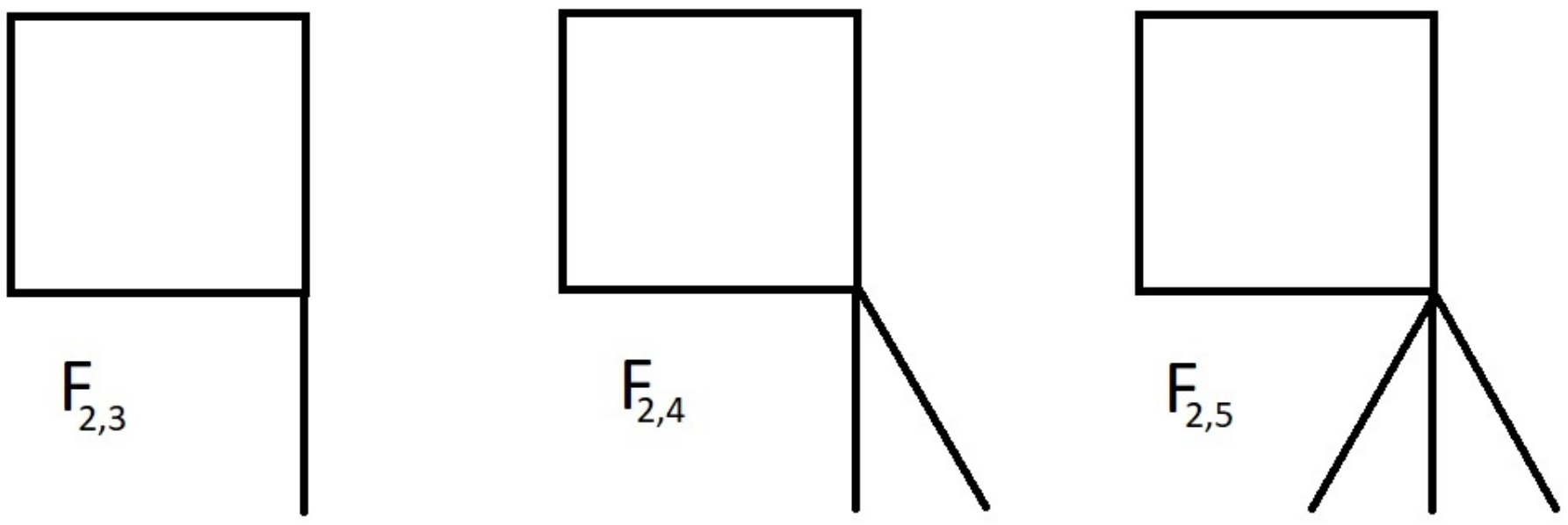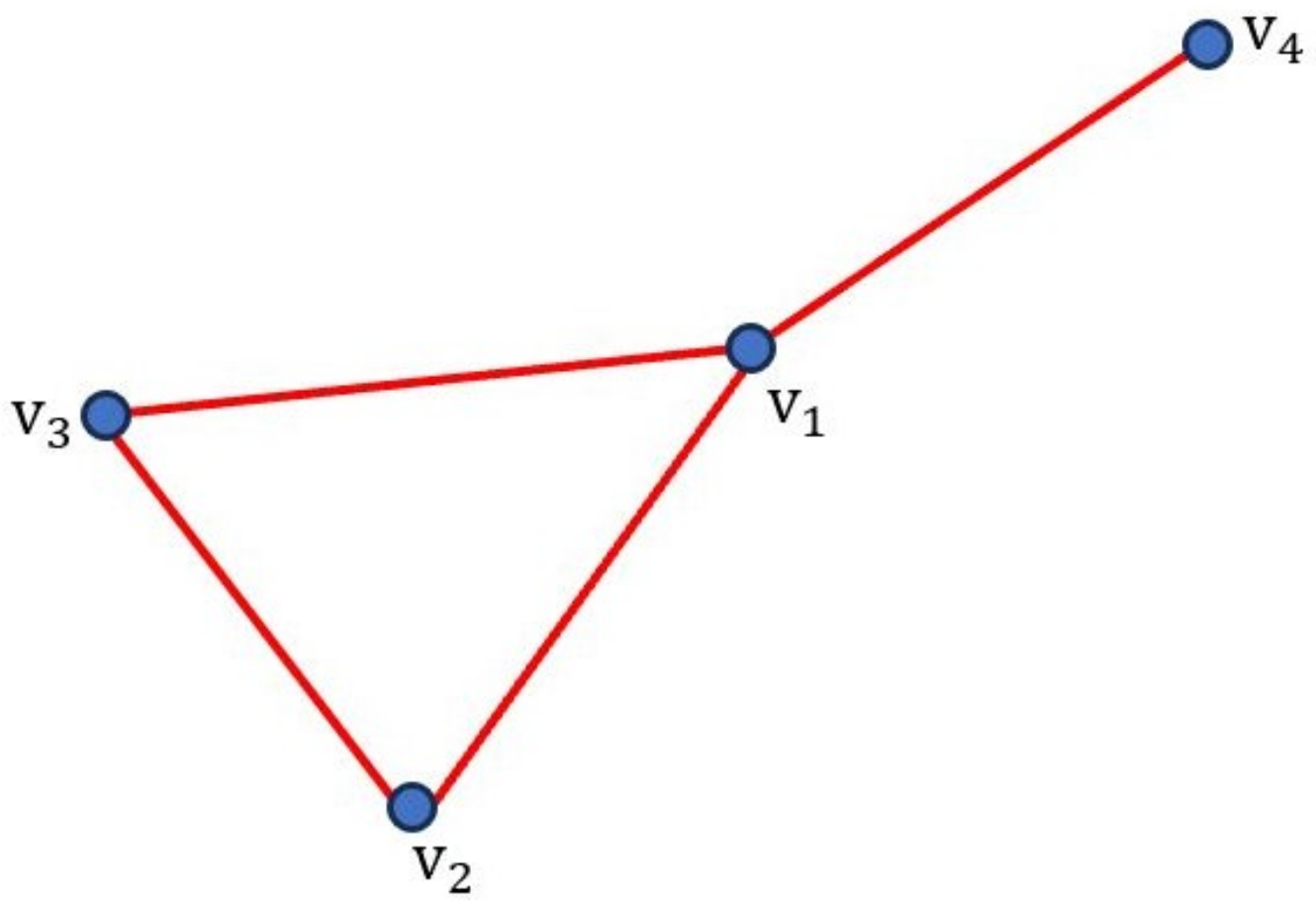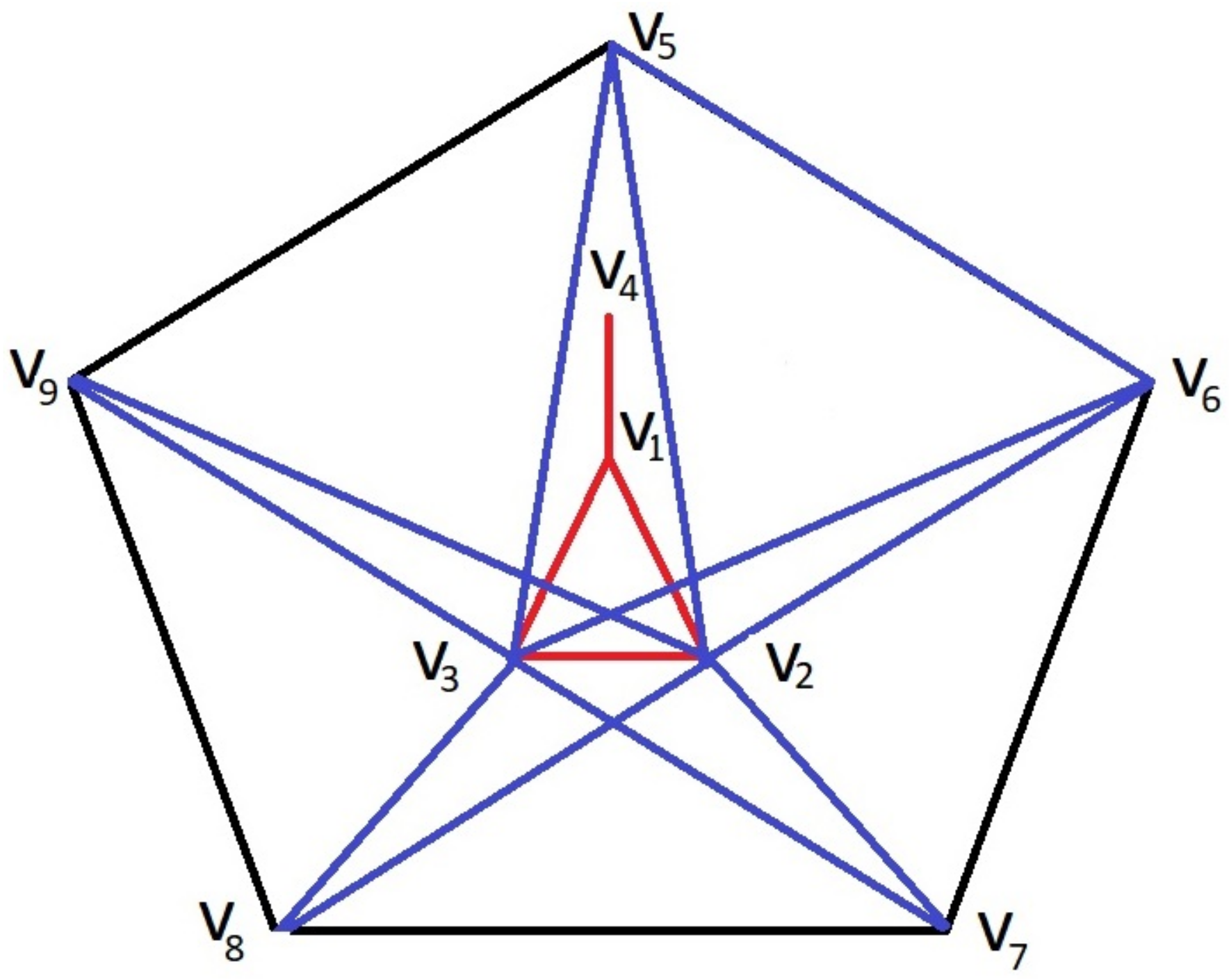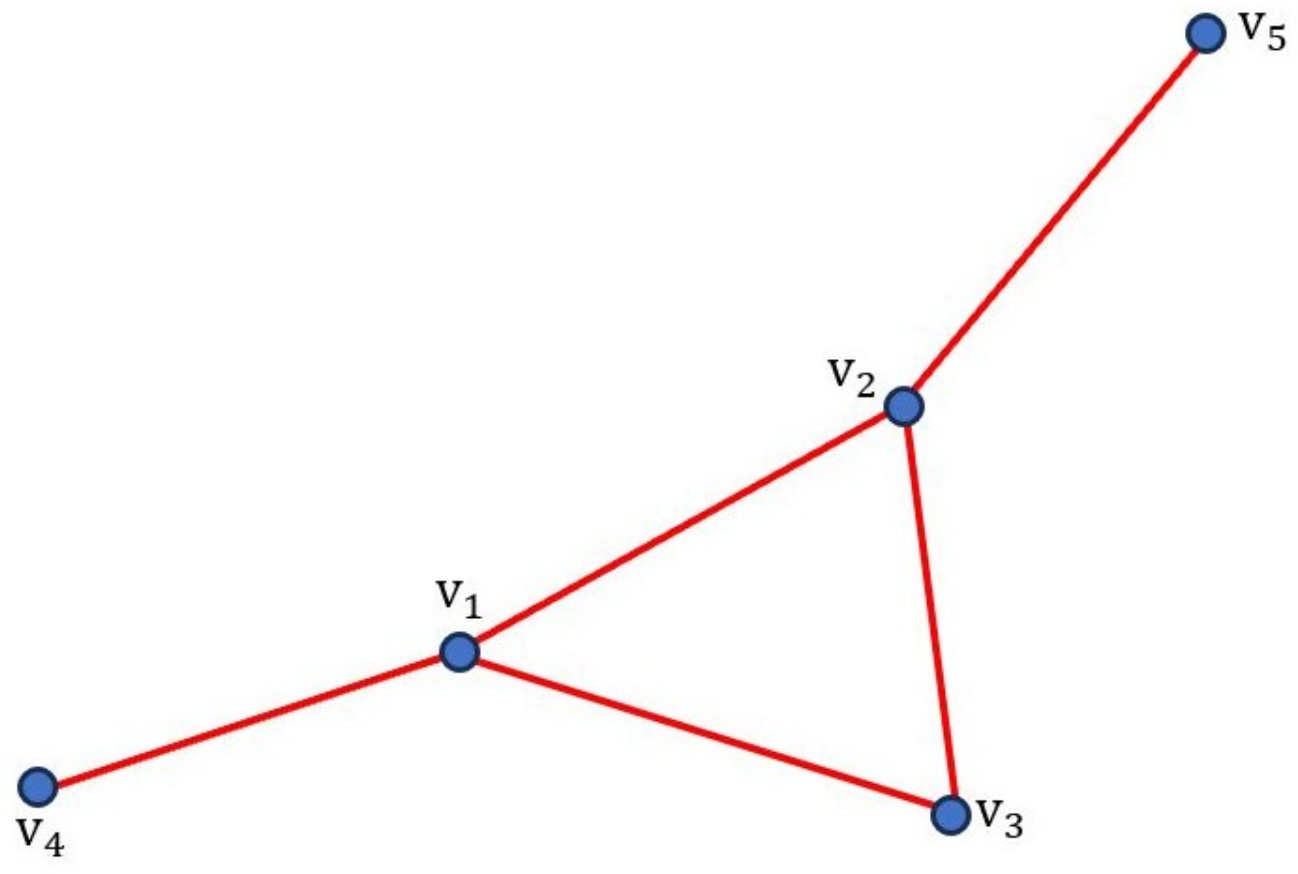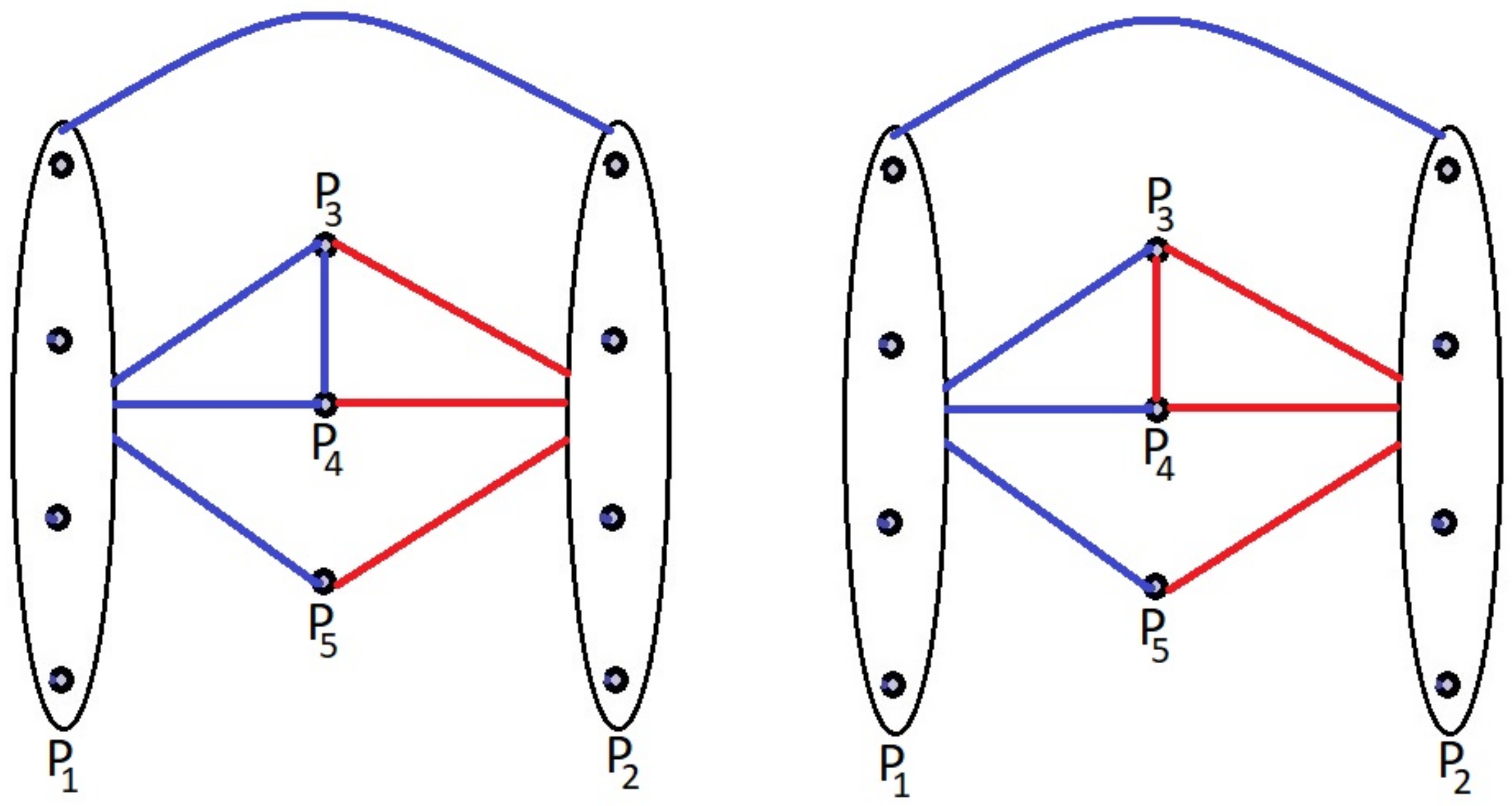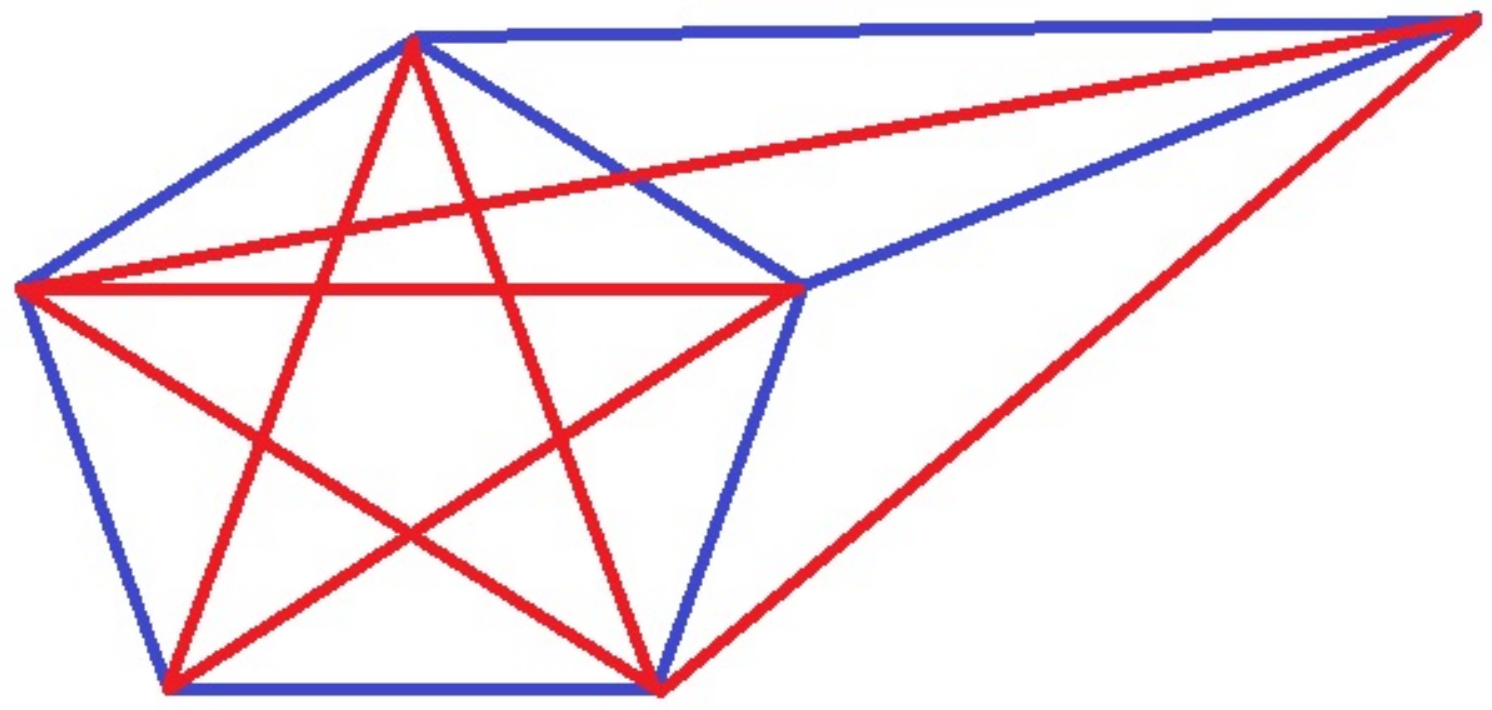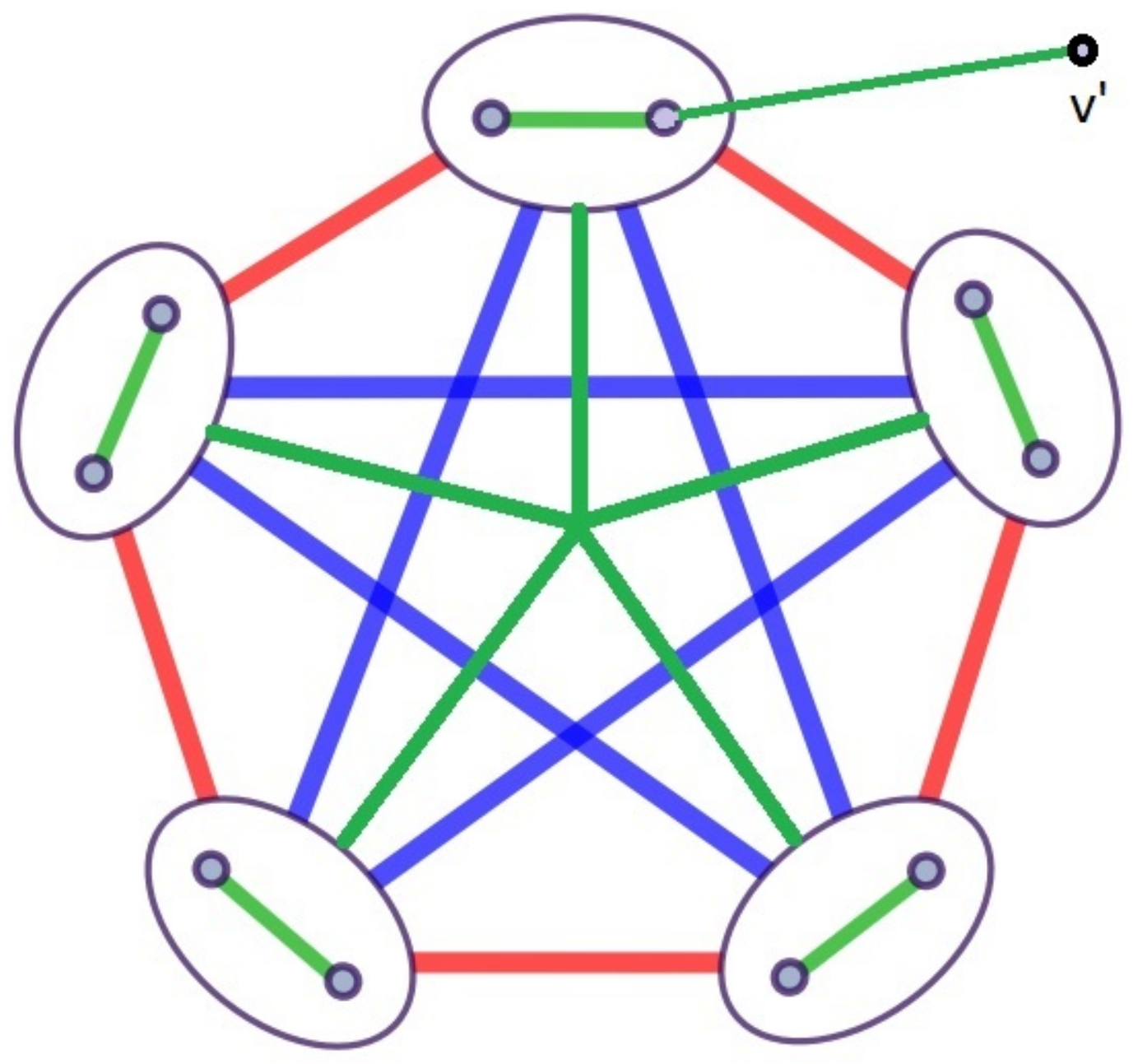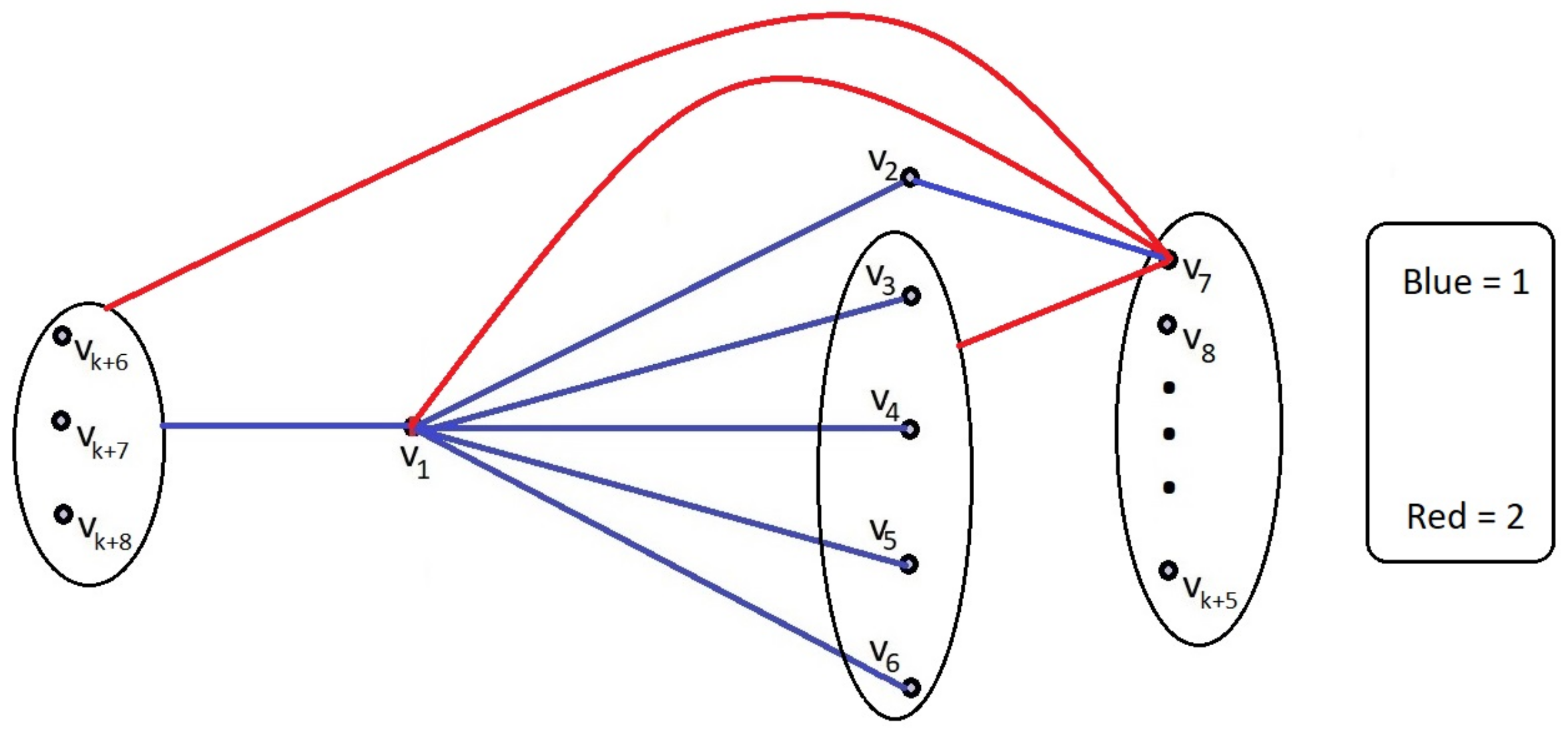This section summarizes the study’s key findings, with an emphasis on the calculation and examination of different Ramsey numbers for cycles with pendant edges. In particular, we investigate the Gallai–Ramsey number, the star-critical Gallai–Ramsey number, the classical Ramsey number, and the star-critical Ramsey number. By giving precise upper and lower bounds for these values, we enhance Ramsey theory and shed light on the structural characteristics of these graphs.
3.1. Ramsey Number
Theorem 6. .
Proof. In order to establish a lower bound, we initially sought to find a graph G of order 8 such that is neither a subgraph of G nor a subgraph of the complement of G. Let us consider graph G defined as . It is well known that the complement of is a bipartite graph . Therefore, , which is a cycle of length 3 with two additional edges, is not a subgraph of either or . Hence, .
It is shown that any 2-coloring of
, using red and blue, must necessarily contain either a blue
or a red
to establish an upper bound. According to Theorem 5, every 2-coloring of
contains a monochromatic
. As illustrated in
Figure 3, let us assume that the vertices of
are
and that
form a red
.
Hence, all edges connecting to vertices must be blue; otherwise, a red would be present.
Now, if there exists a single blue edge, say
, in the subgraph induced by vertices
, then
contains a blue
induced by
and any of the other vertices, as shown in
Figure 4.
As all edges in the induced subgraph formed by vertices are colored red, it follows that graph contains a red . Therefore, there must exist a red .
Thus, we have shown that any 2-coloring of contains either a red or a blue . This implies that , completing the proof of our main result. □
Theorem 7. .
Proof. In order to establish a lower bound, we initially sought to find a graph G of order 10 such that is neither a subgraph of G nor a subgraph of its complement. Let us consider graph G defined as . It is well known that the complement of is a bipartite graph . Therefore, , which is a cycle of length 3 with three additional edges, is not a subgraph of either or . Hence, .
Our goal is to show that every 2-coloring of the complete graph on eleven vertices (
) must contain either a blue
or a red
, thereby establishing an upper bound. According to Theorem 6, any 2-coloring of
must include a monochromatic
. Let us consider a graph
F isomorphic to
. Without loss of generality, let the vertices of
F be
. As illustrated in
Figure 5, vertices
and
form a red
.
Hence, it can be concluded that in any 2-coloring of F, if are colored red to form a red , then all edges connecting vertex to vertices must be colored blue. This is because if any of these edges were colored red, then a red would be formed. □
Claim 1. If there exists a blue in the induced subgraph of vertices , then graph F contains either a red or blue .
Proof. Let us assume that there exists a blue
in the induced subgraph of vertices
, say
, as shown in
Figure 6. If any edge connecting either
or
to vertices
is blue, then a blue
must exist. Therefore, we can conclude that all edges from
to
must be red, and in this case, we obtain a red
, as shown in
Figure 6.
Therefore, we have shown that if there exists a blue in the induced subgraph of vertices , then graph F contains either a red or blue . This completes the proof of the claim. □
It is evident from the above Claim 1 that the induced subgraph formed by vertices is free from a blue (a path of order 3) in any 2-coloring of , and this implies that contains a red .
As a consequence of all the above observation, any 2-coloring of F contains a monochromatic . Therefore, .
3.2. Star-Critical Ramsey Number
Theorem 8.
Proof. By utilizing Theorem 7, we can confidently assert that . However, proving this theorem requires us to first identify all critical colorings of for graph . This leads us to consider graph , which is obtained by adding a new vertex to that is adjacent to k of the pre-existing vertices.
To establish the star-critical Ramsey number, denoted by , we aim to determine the minimum possible value of k such that every red–blue coloring of the edges of , includes either a red or a blue copy of .
By utilizing Theorem 6, we can deduce that any 2-coloring of will inevitably include a monochromatic . To simplify the analysis, we assume that the vertices of are labeled and vertices form a red .
As a consequence of this assumption, we can conclude that all edges connecting vertex
to vertices
must be colored blue. This is due to the fact that if any of these edges were colored red, it would result in the formation of a red
, as depicted in
Figure 7. □
Claim 2. If there exists a blue (a path of order 3) in the induced subgraph of vertices , then graph contains either a red or blue .
Proof. The proof is similar to Claim 1 □
Claim 3. If there exists a blue in the induced subgraph of vertices or , then graph contains monochromatic .
Proof. It is clear from the above Claim 2 that there can be at most two independent blue edges in the subgraph induced by vertices . Hence, all other edges must be red. Therefore, all the edges between and are blue. Otherwise, there would exist a red . This implies that even a single blue edge in the subgraph induced by vertices would create a blue . The same argument can be applied to the other set of vertices. □
Consequently, based on the aforementioned Claims 2 and 3, we can establish that the sole admissible critical coloring of
for the graph
consists of two red
subgraphs, interconnected exclusively by blue edges. A visual representation of this coloring scheme can be observed in
Figure 8.
Thus, it becomes evident that when considering a vertex v, a maximum of two additional (blue) edges can be introduced in the critical coloring of in such a way that the resulting graph does not contain either a red or a blue . As a consequence, every red–blue coloring of the edges of invariably comprises either a red copy of G or a blue copy of H.
Theorem 9.
Proof. The proof is similar to Theorem 8. □
3.3. Gallai–Ramsey Number
Lemma 1.
Proof. In this study, we aim to demonstrate a theorem by employing an inductive methodology to construct a k-coloring scheme for the complete graph . Our primary objective is to devise a coloring approach that possesses two crucial characteristics: the absence of rainbow triangles and the absence of monochromatic occurrences of . It is important to note that the value of n is contingent upon the parity of k and can be mathematically expressed as follows:
In the case where the parameter k is even, a 2-edge-colored complete graph denoted by is considered. This graph, represented by , is constructed by using colors 1 and 2. The proven theorem (referred to as Theorem 7) guarantees the absence of monochromatic in .
Let us assume that
and that a
-edge-colored complete graph
of
has already been constructed, satisfying the absence of rainbow
and monochromatic
, where
Next, a 2-edge-colored complete graph denoted by , represented by , is considered. Colors and are used to color the edges of . It can be proven that does not contain a monochromatic , as the specified colors induce two monochromatic copies of .
To proceed with the construction, is defined as the blow-up of by a factor of 5, denoted by . A blow-up of a graph G, denoted by , is a transformation where each vertex of G is substituted with a distinct edge-colored complete subgraph . The edges in this new graph are assigned colors based on the following rules:
If two vertices
are both in the same subgraph
, their edge maintains the coloring from
, i.e.,
If
x and
y belong to different subgraphs
and
, the color of their connecting edge is determined by the color of edge
in the original graph
G, i.e.,
When all the subgraphs are identical, we simplify the notation to , meaning that each vertex in G is replaced by a copy of F.
By iteratively following this construction process, a
k-edge coloring denoted by
of
is obtained, satisfying the absence of both rainbow
and monochromatic
. The value of
n is determined as
In the case of an odd value for
k (
), it is possible to construct a
k-edge coloring of the complete graph
, denoted by
. The value of
n is determined by
The construction process ensures that does not contain a rainbow or a monochromatic . The proof of this claim relies on a step-by-step construction approach.
Let us consider the scenario where
and a
-edge coloring of
, denoted by
, has been successfully constructed. Here,
Let be a 2-edge-colored complete graph , where colors and are used. It is important to note that is constructed in such a way that it does not contain a monochromatic . By performing a blow-up operation on by using with a factor of 5, denoted by , we obtain graph . □
Theorem 10.
Proof. The lower bound can be obtained by applying Lemma 1. To establish the upper bound, an induction technique will be employed on the variable k. The base case of is self-evident, and the case of is equivalent to Theorem 7. Hence, assuming , let represent a complete graph with n vertices, and let G denote a Gallai coloring of , where n is given by
.
.
Considering the Gallai coloring of G as per Theorem 1, it can be concluded that a Gallai partition exists. Let us denote the two colors present in the Gallai partition as ‘red’ and ‘blue’. The partition is selected in such a way that the number of parts, denoted by m, is minimized. By applying Theorem 7 to the reduced graph, it follows that . The parts of the partition are represented as . Assuming for all i with , we define n as the number of parts in the Gallai partition with an order of at least 5. Thus, , and .
Initially, we examine different cases based on the value of m. Later, we will examine different cases based on the value of n.
Let us assume that . When m = 3, there are at most two colors among parts . Without loss of generality, let us say that the color between and and between and is same. This implies that the vertices of and form a Gallai partition with exactly two parts, which contradicts the minimality of m; therefore, m = 2.
Case m = 2: Now, we assume that all edges between and are red. As , we have , which implies that there is at least one part of order at least 13. Therefore, we have .
Sub-case : The proof for the case when
is similar to the proof given in Lemma 4 of [
26] for the case where
.
Sub-case : To avoid the emergence of a red , it is essential that no red (a path of order 3) exists within ; otherwise, this path, along with (the partition), would lead to the induction of a red . Thus, color 1 (red) generates a subgraph where each component in partition is a .
To prevent the occurrence of both a rainbow
and a monochromatic red
(a path of order 3), it is necessary for each pair of components to be connected by a single color only. Given that
is a subgraph of
and
, the prevention of monochromatic
necessitates that
comprises no more than
components. Removing up to
k vertices guarantees the absence of edges of color 1 (red) within partition
. Consequently, we derive the bound
which results in a contradiction.
Sub-case : If for i = 1, 2, then in order to avoid a red , there can be no red edges within and . Since a color is missing within each , we can apply induction on k within each . This implies that which is a contradiction. Therefore, we can assume that .
By assuming that and , it can be shown that any selection of six parts, including and , will result in a reduced graph containing a monochromatic triangle. This triangle must include at least one part from the set , indicating that the corresponding subgraph of G contains a monochromatic copy of , which contradicts our assumptions. Thus, it follows that either or n is less than or equal to 3.
To proceed further, we will examine different cases based on the value of n. □
Claim 4. Let us suppose that we have a Gallai partition with multiple parts, where the number of vertices in each part is less than 5 and all the edges between pairs of these parts are monochromatic. In this case, the total number of vertices in these parts cannot exceed 8.
Proof. Let us denote the parts by
. When
, the conclusion is evident and requires no further explanation. However, in the case where
, if we assume that all these parts are connected solely by red edges, it becomes evident that a red
emerges by virtue of three distinct vertices (
) originating from different parts. Hence, we can have at most three more vertices to avoid red
, as shown in
Figure 9.
□
Claim 5. Let and be two parts of a Gallai partition, each having an order of at least 4. Let us suppose that c represents the color of the edges between and . In this case, it can be observed that there are no other parts in the Gallai partition that possess edges of color c connecting both and .
Proof. Let us suppose that there exists a part in the Gallai partition that has color c edges connecting both and . In this case, the union of , , and denoted by contains a monochromatic copy of . This leads to a contradiction. Therefore, the assumption of the existence of with color c edges connecting both and is false. □
Claim 6. Let us consider and , two parts of a Gallai partition, each with an order of at least 4. Let us assume that there are blue edges between and . In this scenario, it can be observed that if there is one part in the Gallai partition that has blue edges connecting to and red edges connecting to and the order of is at least two, then it is unique. Otherwise, there can be at most two parts with an order equal to 1. Similarly, there can be at most one part with red edges connecting to and blue edges connecting to or two parts with an order equal to 1.
Proof. To arrive at a contradiction, let us assume the existence of two parts, and , of order greater than or equal to 2 in the Gallai partition. These parts have red edges to and blue edges to . Now, let us consider the edges between and .
If the edges from to are red, then the union contains a red copy of . This contradicts the assumption. On the other hand, if the edges from to are blue, then the union contains a blue copy of . Once again, this contradicts our assumption.
If there exist three parts
, and
of order 1, then a monochromatic
also exists, as shown in
Figure 10.
Thus, in each case, a contradiction is reached.
The proof is indeed symmetric for two parts with red edges to and blue edges to . □
Case n = 0: Let us consider the case where , meaning that there are no parts in the Gallai partition with an order of at least 5. Our focus is on the colors of the edges from to . Let represent the union of the parts with blue edges to , and let denote the union of the parts with red edges to .
Let us suppose, without loss of generality, that
is at least 5. In this case, there can be no blue edges within
, as it would lead to the formation of a blue
. Consequently, all edges between the parts in
must be red. By applying Claim 4, we can deduce that
. Similarly, we have
. Thus, we have
which results in a contradiction.
Case n = 1: In this case, let . Let us assume that represents the collection of parts that have red edges connected to , while represents the collection of parts that have blue edges connected to . Similar to the previous scenario, we can conclude that the size of is less than or equal to 8, and the size of is also less than or equal to 8. Given that m is the minimum value, it can be inferred that and cannot be empty. Consequently, there are no blue or red edges within . We can conclude that the size of G is equal to the sum of the sizes of , , and , i.e., . This value is less than or equal to . However, this value is less than n, indicating that the size of G is less than the given value of n.
Case n = 2: Let us consider the following scenario: The color red is designated for the edges connecting and . Consequently, neither nor can contain any red edges. Furthermore, according to the assertion made in Claim 5, it is impossible for a component to possess red edges leading to both and . In addition, Claim 6 postulates that there can be at most one component, denoted by , which features red edges connecting to alongside blue edges leading to . Similarly, there can exist at most one component, denoted by , with blue edges linking to and red edges connecting to . Let us define as the collective set of the remaining components that possess exclusively red edges connecting to . Based on the findings of Claim 4, we can deduce that the cardinality of must satisfy the inequality .
By virtue of the minimality of m, every part in question exhibits incident edges from other parts in both red and blue. This implies that neither nor possesses any red or blue edges. Consequently, we can infer that the cardinality of is limited by , leading to . Hence, we can calculate the overall size of G by summing the sizes of , , , , and , expressed as . We can conclude that the size of G is less than or equal to , which is less than n, so it is a contradiction.
Case n ≥ 3: In order to prevent the occurrence of a monochromatic copy of , it is crucial to ensure that the triangle formed by the reduced graph, represented by the parts , does not consist of edges of a single color. Let us assume, without loss of generality, that the edges connecting to are red, while all edges from to are blue. As a result, both and will not contain any red or blue edges, whereas will lack blue edges.
The first claim is that there cannot be a part with blue edges to . If there were such a part, let us call it and assume that it has blue edges to . To avoid a blue copy of , all edges from to must be red. However, this means that contains a red copy of , which is a contradiction. Thus, all edges from to must be red. As m is greater than or equal to 4, this means that does not contain any red edges either. Therefore, we have for
This paragraph describes the potential existence of certain parts in the graph. According to Claim 6, there is at most one part
that has blue edges connecting it to
and red edges connecting it to
. Similarly, there is at most one part
that has red edges connecting it to
and blue edges connecting it to
. Additionally, there is at most one part
that has blue edges connecting it to both
and
. It is important to note that the union of
,
, and
is not empty, as the value of m was chosen to be minimal. Hence,
Case n ≥ 4: When considering the case where n is greater than or equal to 4, it can be deduced that . Within the subgraph of the reduced graph, which is induced by the n parts having an order of at least 5, it has been previously established that the existence of a monochromatic triangle is not possible. If n is equal to 5, there exists only one coloring of that satisfies this condition. Conversely, if n is equal to 4, there are two possible colorings of that exhibit no monochromatic triangle. In both of these colorings, each vertex has at least one incident edge of each color, indicating that all corresponding parts with an order of at least 5 do not contain any red or blue edges.
Consequently, we can calculate the size of G by summing the sizes of all parts, expressed as . This sum is less than or equal to . However, this value is less than n, which leads to a contradiction. Thus, this concludes the proof for this case, as well as the proof of the theorem.
3.4. Star-Critical Gallai–Ramsey Number
To prove that , the following two steps need to be taken:
Create a Gallai k-coloring of graph that does not have a monochromatic copy of H. This will show that .
Show that any Gallai k-coloring of graph contains a monochromatic copy of H. This will prove that .
Theorem 11. For any integer , .
Proof. By Theorem 3,
. We know that
. Therefore, we only need to prove that
. Let
, with two colorings, red and blue, as shown in
Figure 11. Clearly, G contains neither a rainbow
nor a monochromatic
.
When l = 2. From the above observation, it is clear that if l = 2 then implies that
Case when . We start by outlining the process used to determine the lower bound. Let us consider graph
, with edges colored 1 (red) and 2 (blue), as shown in
Figure 11, ensuring that it does not contain a monochromatic
. To construct
, we begin with
and iteratively add a new vertex for each
i from 3 to
l. Each new vertex is connected to all existing vertices in
, with the new edges colored
i. This process continues until we obtain
, where each
is formed by adding a vertex to
and coloring the new edges with
i. It is worth noting that
can be viewed as a structure combining the complete graphs
and
. Furthermore,
does not contain any rainbow
or monochromatic
. Hence,
. □
Theorem 12. For any integer , .
Proof. By Theorem 3,
. We know that
. Therefore, we only need to prove that
. Let
, with two colorings, red and blue, as shown in
Figure 12. Clearly, G contains neither a rainbow
nor a monochromatic
.
Case when k = 2. From the above observation, it is clear that if k = 2 then implies that
Case when . Let us start by explaining the construction that resulted in the lower bound. Let us consider graph
with edges in color 1 (red) and 2 (blue), as shown in
Figure 12, without monochromatic
. To construct
,
, …,
, we follow a similar procedure to the one used in Theorem 11. We start with an initial graph
, and then for each value of
i from 3 to
k, we add a new vertex to the graph and connect it to every vertex in
by using edges of color
i. This generates a new graph
that has one more vertex than
, and all the edges added in this step are colored with the value
i. We repeat this process for all values of
i from 3 to
k to obtain the sequence of graphs
,
, …,
. It is worth noting that the graph represented by
is the result of combining the complete graphs
and
. Furthermore,
does not contain any rainbow
or any monochromatic
. Hence,
.
□
Lemma 2. When k is equal to 3, the coloring of shown in Figure 13 is the only way such that it contains neither a rainbow nor a monochromatic . Proof. By Theorem 4, contains either a rainbow or a monochromatic . Let us suppose that the complete graph contains a monochromatic , denoted by H, with vertices and edge colored green (color 3). Let denote the set of remaining vertices, which is . To avoid having a monochromatic in the graph, there can be at most one edge colored green (color 3) between each vertex (where ) and vertices .
For the first case, let us suppose that
(red). Then, edges
cannot have color 2 (blue); otherwise, there exists a rainbow triangle
, as shown in
Figure 14.
Now, for all other , (red); otherwise, we have a rainbow triangle or monochromatic . Hence, there does not exist (red) or (blue).
For the second case, if there is a coloring as shown in
Figure 15, i.e.,
(red),
(blue), and
, then there are two sub-cases such that
and
or
and
.
In the first sub-case, there always exists a rainbow triangle . In the second sub-case, there are always at least two red or blue edges in the edge set for . Hence, there exists either a red or a blue . From the above observation it is clear that ‘u’ is connected to the green (color 3) edges at each vertex.
Now, we prove that every vertex of a graph - u is associated with exactly one green edge. Let us suppose that has no green edge; then, there exists an either red or blue with center . By the same logic as ‘u’, is also connected to each vertex of by red–blue edges. But this is a contradiction, as has at least one green edge and is arbitrary, so each vertex has at least one green edge.
Now, if we say that has two green edges () and (), then graph has a cycle of order 4 (), so there exists a monochromatic .
Therefore, based on all the above arguments, it is clear that only one critical coloring for
is possible, as shown in
Figure 13. □
Lemma 3. For any integer , .
Proof. By Theorem 3,
. Initially, we obtain the lower bound. Let us consider graph
, with edges in color 1 (red), 2 (blue), and 3 (green), as shown in
Figure 16, without a monochromatic
.
To construct , , …, by using the approach described in Theorem 11, we begin with an initial graph . We then construct a sequence of graphs by adding a new vertex to the previous graph and connecting it to every vertex. We then color the edges incident to the new vertex with a new color that has not been used before. This process is repeated for all values of i from 4 to k to obtain a sequence of graphs , , …, . It should be noted that the graph denoted by is obtained by adding edges to the complete graph . Additionally, does not have a rainbow or any monochromatic . Hence, . □
Theorem 13. For any integer , .
Proof. To establish the lower bound , we can utilize Lemma 3.
By applying Lemma 2, we can determine that for , the inequality holds true.
Case when . By utilizing Theorem 3, we can confidently assert that . So, to prove this theorem, we find all critical colorings of such that it does not contain a monochromatic or a rainbow triangle. To establish the star-critical Gallai–Ramsey number, denoted by , we aim to determine the minimum possible value of l such that every k-coloring of the edges of includes a monochromatic copy of or a rainbow triangle.
Because , we have . Therefore, by using Theorem 4, we can conclude that any k coloring of will contain a monochromatic . For the sake of clarity, we shall label the k colors as the numbers 1, 2, 3, …, up to k, while the vertices shall be denoted by . Without loss of generality, let us assume that vertices form a monochromatic with as the center, in color 1 (blue). To prevent the formation of a monochromatic subgraph, we enforce the rule that for each , there can be at most one edge utilizing color 1 in the set of edges . □
Claim 7. In the scenario where any two edges originating from and connecting to vertices share a common color (excluding color 1), an intriguing outcome arises. It implies that graph will invariably encompass either a monochromatic subgraph or a captivating rainbow triangle.
Proof. We can prove this claim by employing a contradiction argument. Let us assume, without loss of generality, that . In this case, we have a cycle in color 2, represented by , where . This cycle, combined with vertices , forms a monochromatic centered at either or . This directly contradicts our assumption that the graph does not contain a monochromatic . □
From the above claim, it is clear that graph
contains a
of color 1 (blue) where
. This is illustrated in
Figure 17.
Claim 8. For each , if , where , then there can only be color l in the set of edges ; otherwise, there exists a rainbow triangle or .
Proof. Let us assume that
and that there exists an edge, let us say
, with a color
different from 2 in the edge set
Case 1 (): If and , then we can observe the presence of a rainbow triangle formed by vertices .
Case 2 (): If
and
, then all the edges of color
in the edge set
must be present. This is because if a single edge of color other than 1 or 2 is present, a rainbow triangle is formed. On the other hand, if there is a single edge of color 1 in that set, a monochromatic
with center
would exist.
Based on the observations discussed above, we can determine the possible coloring of the graph, as shown in
Figure 18 below.
By examining
Figure 18, it becomes evident that any coloring of the edges connecting
to
would inevitably result in the formation of either a rainbow triangle or a monochromatic
. □
Claim 9. If edge set contains a (path with three vertices) of color 1, then the graph will have a monochromatic .
Proof. We can make the observation, from
Figure 17, that the existence of a
(a path of order 3 ) of color 1 leads to the formation of a
when combined with vertex
. Consequently, this results in a monochromatic
centered at
. □
Claim 10. The claim states that if edge set contains a (path with three vertices) of color l (excluding color 1), then for .
Proof. Let us assume that there exists a (path with three vertices) of color l in the given edge set, where l is any color except 1. This can be denoted by , where are distinct vertices in the set .
Let us suppose, for contradiction, that for some i where . This means that there exists an edge of color l between and . Now, let us consider the subgraph formed by vertices . This subgraph contains a monochromatic . From Claim 8, we can deduce that all the edges from to are of color l. This implies that there exists a monochromatic with cycle and center . This contradicts our assumption that the graph does not contain a monochromatic .
Therefore, we conclude that for , as claimed. □
Claim 11. If there exists an edge of color l (excluding color 1) in edge set , then for any , we have .
Proof. Let us assume that there exists an edge of color l in edge set . We want to show that for any .
Since edge has color l, without loss of generality, let us assume that . Now, let us consider vertex . According to Claim 8, all the edges from to vertices are of color l. Furthermore, we can observe that any coloring of the edges from and to would result in either a monochromatic or a rainbow triangle, both of which contradict our assumption.
However, this contradicts the assumption that the graph should not contain a monochromatic . Therefore, we can conclude that for any .
Thus, the claim is proven. □
Claim 12. If and , where and , then or .
Proof. Let us assume that and . Since and , the only possible colors for edge are l and . This is because if edge is colored with any other color, it would form a rainbow triangle with edges and , which contradicts our assumption.
Therefore, we can conclude that or . □
Claim 13. The set of edges can have at most distinct colors, and any color other than 1 can be assigned to at most one edge.
Proof. The edge set must have at least two colors other than 1; otherwise, there would exist a monochromatic in the graph. Hence, by applying Claim 11, we can conclude that the given edge set can have at most distinct colors. □
By using all the above claims and Lemma 2, the critical k - coloring of is as follows:
The coloring of the subgraph induced by vertices by using colors 1, k-1, and k can be performed in a similar manner as shown in Lemma 2.
Thus, it becomes evident that when considering a vertex v, a maximum of additional edges can be introduced in the critical k-coloring of , such that edges satisfy , where j belongs to , and one more edge can be attached from v to any vertex from the remaining vertices of . This construction ensures that the resulting graph does not contain either a rainbow triangle or a monochromatic .
As a consequence, it follows that every k-coloring of the edges of invariably comprises either a rainbow triangle or a monochromatic , demonstrating the critical nature of the graph.
